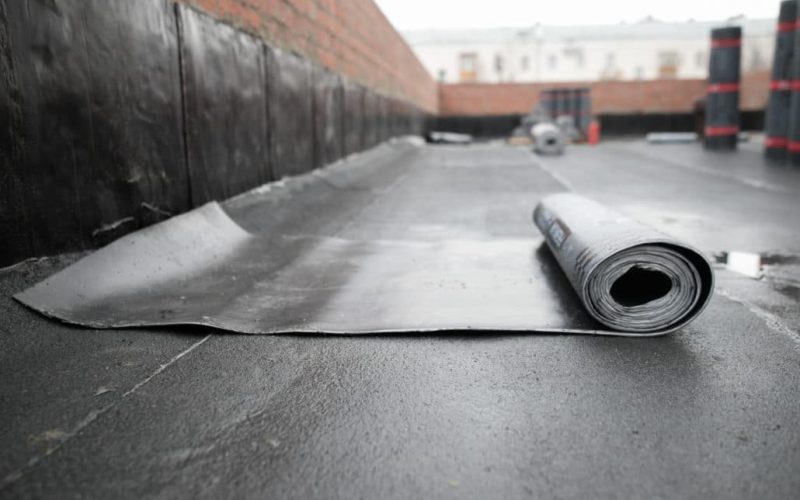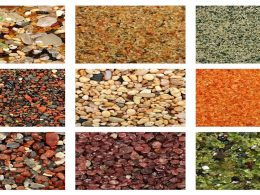They are a combination of sawdust, slate dust, recycled tires. It comes in rolls of long, overlapping sheets to be used on flat roofs.
It can as well come in shingles, possessing a slate tile appearance. This roofing is spread on thoroughly cleaned, stripped decking of a roof that has been covered with adhesive.
The rubber rolls are cut to fit, spread across the roof, then smoothed out to remove air bubbles.
For a more attractive option, rubber shingles are placed on top of the rubber roof. The rubber seams are taped and sealed before nailing down the rubber shingles in rows.
These rubber roofs are considered one of the most durable and inexpensive options for flat roofs.
When they are properly installed, they rarely leak nor need much maintenance, and can last for up to 20 years.
Types of rubber roofing
Now, just like every other form of product, these rubber roofing come in three major types.
They include Built-up roofing (BUR), Single ply membranes, and modified bitumen.
1. Built-up roofing (BUR)
Built-up roofing is majorly known as “tar and gravel” roofing. The “tar” is particularly a black, viscous substance called bitumen.
This is a mix of hydrocarbons that is naturally derived or made from distilled petroleum residue. Simply put, it is made out of asphalt, cold-applied adhesive, or coal tar.
The bitumen is applied on strong, reinforced fabrics known as membranes or ply sheetings, in a pile-up manner at least four times.
In the last layer, crushed rocks or gravel are used for coating the built-up roofing. Sometimes, a base sheet is placed down first and fastened, then a fully adhered BUR is laid directly on the roof deck or insulation.
Lifespan of BURs
This type of rubber roofing is highly dependent on the climatic condition in the area as well as the material used.
On average, BURs have a life expectancy of fifteen to thirty years. However, some can stay up to 40 years. Generally, BURs do better in warmer conditions than cold areas.
The life span of BURs has made it comparable to asphalt shingles, which have a life span of 15 to 30 years based on quality.
Cost of BUR
The average installation price for tar & gravel (built-up) roof costs about $3,750 to $6,750 depending on the slope, pitch, and size of the roof.
A square foot can be gotten from $2.50 to $4.00 or $250 to $400 for standard size installation on a single-story house.
Maintenance
In doing routine built-up roofing repair and maintenance, a proper coating is highly necessary. This protects it from solar damage.
It is paramount to know that this coating is way different from waterproofing. The coating does not prevent water leakage as it is not built for stopping leaks.
A leaking-free BUR is a sole dependent on proper installation and maintenance of the roof’s flashings.
An ill coating deteriorates quicker making it susceptible to premature leaking.
Proper coating of this type of rubber roofing entails meticulous preparation before its coating application.
This includes re-sealing leakages found; repair of damaged or aged-out flashing; inspection and repair of cracks or gaps in the roofing materials; then a thorough surface clean-up of the roof before the coating is applied.
It might be considered an extra expense, but it ensures the long-lasting benefits of this built-up roofing.
These coatings are to be applied between four and six years. But the roofs should be inspected at most once in a year to fish out any anomaly before it gets worse.
Pros
Non-flammable/ Water Resistance
While you might think that tar is flammable, it takes a good degree of heat to cause an ignition. Also, the bitumen’s tightened layer creates waterproof roofing, stopping water from seeping into the building.
Durable
With an added fiberglass and aggregate, BUR roofing comes out very sturdy. Because of its strength, the roof can easily withstand tough weather conditions.
Low Maintenance
This type of roofing is widely applauded for its low-maintenance qualities. Yet, a good number of owners choose to inspect it once or twice yearly to ensure it’s of a good standard.
Its low cost and minimal upkeep have made BUR one of the best types of rubber roofing for individuals on a budget.
Energy Efficiency
Today, most built-up roofing systems are equipped with a high reflective layer. This protects them against UV rays, thus keeping the inside and the surrounding area cool.
This would as well reduce the use of an excessive cooling system for the building.
Cons
Everything has its drawbacks, BUR is no different. While maintenance is on the low side when it comes to this roofing, it isn’t nonexistent.
Some things should be looked out for during seasonal inspection of commercial roofing.
They include;
Split Joints
Split or open joints are dried out or separated seams at the center of two rolls. When this happens, the best solution is a replacement.
However, for a more economical approach, a patch is used to hold these splits. For any of the options to be used, a professional should be consulted.
Water Pooling
Water pooling is a tiny issue that can cause gigantic problems down the line. Inspections on the BUR after strong weather is highly advised to ensure there are water pooling problems.
When it goes unchecked, a commercial roof can leak or crack, encouraging the development of soft spots and other warping problems, like undulations, waving, and blistering.
2. Single-Ply Membranes
This is one of the types of rubber roofing made up of sheets of rubber and other synthetic materials that can be chemically adhered to insulation or ballasted to create a protective layer for commercial buildings and facilities.
The single-ply Membrane is of two major types: Ethylene Propylene Diene Terpolymer (EPDM), and Thermoplastic Polyolefin (TPO).
The difference between these two is in the chemical makeup, their energy efficiencies, and how they are installed.
EPDM is considered to be one of the best materials for flat roofs in the market. It is a popular choice for commercial and industrial applications due to its ability to withstand drastic weather conditions.
It is tear-resistant, requires little maintenance, and possesses good insulation properties.
TPO is an adhered or mechanically attached membrane. This roofing system can be left bare throughout its life span.
In addition to this, it is environmentally friendly with high resistance to ultraviolent, chemical, and ozone exposure.
Lifespan
EPDM, when properly cared for, can last for as long as 10-15 years while Thermoplastic Polyolefin (TPO) has a life span of 15 to 20 years.
Cost
For EPDM, you could spend an average of $5.01-$5.92 per square foot installed. For a 1,600 square feet roof coverage, you can spent about $8,013.46- $9,470.88.
For TPO, you could spend an average of $5.47- $6.38 per square foot installed. For coverage of 1,600 square feet, it can cost between $8,740.24- $10,197.35.
Maintenance
Regardless of the material, the initial step for any roof system is regular inspection.
All areas of the roof should be inspected especially after extreme weather conditions like hail, new rooftop appliances, or more than usual foot traffic on the roof due to other installations.
The in-house could do it themselves or pay a contractor for regular check-ups and inspection.
The key element of all roof inspections is to ensure that signs of damage are detected on time and repaired before further, severe issues are incurred. Damages to the roof are insidious.
Tiny holes and cracks that might look minor in the joints and seams can morph into bigger holes and cracks when water penetrates.
Pros
Easy installation
Unlike the complex processes involved in spray polyurethane foam roofs, a simple-ply membrane is way easier to install.
After the preparation of the existing substrate by removing the previous roof, the insulation layers are installed and covered using a cover board.
Lightweight and flexible
Even with multiple layers, you can choose your desired degree of membrane thickness for your roof.
In general, single-ply membrane roofing is lighter compared to other commercial flat roofing systems. This goes a long way in relieving the stress placed on the building.
The single-ply membrane and its flexibility allow the contractor to create unique roof designs. The flexibility helps the roofing system stay intact when it comes to contracting and expanding buildings.
Cons
Membranes are easily punctured
This is the downside of the lightweight quality of the single-ply membrane roofing. They do not possess a rigid top layer to protect the synthetic material from tools, loose screws, and gravels dropping on it.
This type of damage would create holes in the insulation and the rubber, making it susceptible to leaks.
Seams are susceptible to leaks
Installation of these roofing systems is rolled out, overlapped, and fastened together with either mechanical fasteners, heat, tapes, or adhesives.
Though the seams are closed up, they are still at risk of leaking.
UV Rays
The direct contact of UV rays on the roof can degenerate the adhesives in quick succession over time. This is causes leakages from the seam.
Then, if there is a tear, puncture, or any other form of damage, the UV rays would penetrate, causing more harm to the adhesives.
3. Modified Bitumen (MB)
Modified Bitumen roofing is the third type of rubber roofing. It is asphalt-based, closely related to the built-up roof (BUR).
It is designed for low-slope or flat roof buildings and structures. This rubber roofing originated in the mid-1960s in Europe and has been successfully integrated into Canada and Europe since approximately 1975.
Modified Bitumen roofing is designed to withstand extreme exposures and harsh environmental elements.
With over five protective layers, this roofing system has proven to be one of the highly trusted roofing systems used in the industrial world.
Lifespan
Modified bitumen roofing has an average life span of 20 years. However, with its low maintenance requirements, these roofing systems can last for more years provided that it is given the basic care.
Cost
The average price of the modified bitumen roof per square foot is $4.00-$5.55. Installation cost ranges from $220.00- $340. The material price ranges from $165.00-$250.00.
Maintenance
Even the premium material can still result in roof failure when they are properly installed. You should ensure all system components comply with the manufacturer’s requirements and specifications.
This means vigilant monitoring during job construction is highly recommended. Then again, this task should be performed by a representative of the manufacturing company.
Proactive maintenance is the final element to roof life extension. The success of roofing is a responsibility shared amongst building owners.
A homeowner will not expect their roof to survive several freeze-thaw cycles without periodic cleaning of the roof gutters.
Pros
Tolerance
One of the largest advantages associated with the use of modified bitumen roofing is its tolerance for cold weather.
This roofing material was designed to stay flexible, even when it’s cold. It does not become brittle in unfavorable weather and is less likely to crack and leak.
Self-adhering
A lot of commercial buildings have flammable and/or heat-sensitive structures and appliances on their rooftops.
And, traditionally, the installation of modified bitumen involves the use of torches or some other form of heat treatment for the installation of the roofing membrane.
However, the latest types of modified bitumen roofing systems are self-adhering.
Low volatile organic compound
The use of self-adhering modified bitumen is easy and effective. There won’t be any form of heat-related accidents during installation.
This makes it a huge safety advantage for workers and anyone in the building.
Whilst talking about safety, the self-adhering options also have low volatile organic compound (VOC) components, which means that workers making installations on the roof won’t be inhaling dangerous chemicals on the job, and the materials won’t be releasing toxic substances into the air.
Con
Potential Fire Hazards
An older style of modified bitumen roofing involves the use of heat for installation which is a fire hazard because a lot of structures have wooden components near the roof.
Fortunately, this type of roofing technology has made a huge advancement. Many more manufacturers are moving toward the use of cold-adhesive and self-adhering modified bitumen.
Conclusion
These are the three major types of rubber roofing. They are excellent choices for individuals in search of long-lasting roofs.
These pros and cons indicate that they are good roofing materials as long as they are properly installed and maintained.









